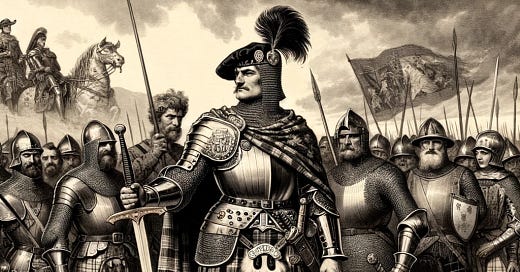The medieval era, a tapestry woven with the valor of knights and the fervor of crusades, serves as the backdrop to the legendary exploits of Alexander Pringle, a figure whose courage and leadership echo through the annals of Scottish history. This narrative ventures beyond mere dates and maneuvers, delving into the heart of a man driven by faith, honor, and the call to arms in one of history's most convoluted and dramatic chapters: the Fourth Crusade.
The Call to Crusade
In the twilight of the 12th century, Christendom was ablaze with the zeal to reclaim Jerusalem, lost to Saladin's forces. Amid this fervor, Alexander Pringle emerged from the rugged landscapes of Scotland, driven by a potent mix of devout faith and a knight's quest for glory. The Fourth Crusade, proclaimed by Pope Innocent III, was not merely a military campaign for Pringle; it was a divine calling, a path laid before him by the heavens themselves.
As Pringle set sail from the shores of Scotland, leaving behind the rolling hills and stoic castles of his homeland, he entered into the vast tapestry of the Crusading world. The journey was perilous, fraught with storms and uncertainties, but Pringle's resolve remained as steadfast as the Scottish crags. Upon reaching the Holy Land, he found himself not in the anticipated landscapes of Jerusalem but in the midst of political machinations that would lead the Crusaders to the gates of Constantinople.
In the Shadow of Constantinople
The Fourth Crusade's diversion to Constantinople, a Christian city rich in treasures and history, was a stark departure from its original sacred mission. It was here, in the shadow of the city's towering walls and gilded domes, that Alexander Pringle's mettle was truly tested. As one of the Scottish commanders, he led his contingent with a blend of tactical acumen and fearless valor, qualities that earned him the respect of his peers and the fear of his foes.
The siege of Constantinople was a spectacle of war that few could have anticipated. Pringle and his fellow Crusaders, entangled in a web of Venetian intrigue and ambition, found themselves assaulting the heart of Eastern Christianity. The ensuing conflict was brutal, a stark juxtaposition to the Crusaders' intended holy war. Through the bloodshed and the flames, Pringle fought not for plunder but for survival and the remnants of his tarnished honor.
Legacy Cast in Stone and Story
The aftermath of the Fourth Crusade left Christendom divided and the path to Jerusalem further obscured. Yet, for Alexander Pringle, the journey did not end at Constantinople's breached walls. He returned to Scotland, a changed man, carrying with him the scars of battle and a crest adorned with a winged heart—emblematic of his Crusading valor and a poignant reminder of the aspirations and calamities that had unfolded.
This emblem, a legacy of his participation in the Fourth Crusade, became a heraldic symbol for the Pringle family, signifying their ancestor's adventurous spirit and his complex legacy. It is a testament to the fact that the tales of knights and their exploits, while grounded in the brutal realities of medieval warfare, also soar in the realms of honor, sacrifice, and eternal quest.
Alexander Pringle's story is more than a chapter in the chronicles of the Crusades; it is a narrative of personal ambition entwined with the collective destiny of an era. His adventures and exploits, from the windswept highlands of Scotland to the sun-drenched fields of Palestine and the majestic walls of Constantinople, reflect the broader human experience of seeking purpose amidst chaos, of striving for honor in an era defined by conflict.
In recounting the odyssey of Alexander Pringle, we are reminded of the enduring allure of the knight-errant's quest and the complex tapestry of history, where heroes and their legacies are forged in the crucible of their times, leaving behind stories that captivate and inspire generations.





